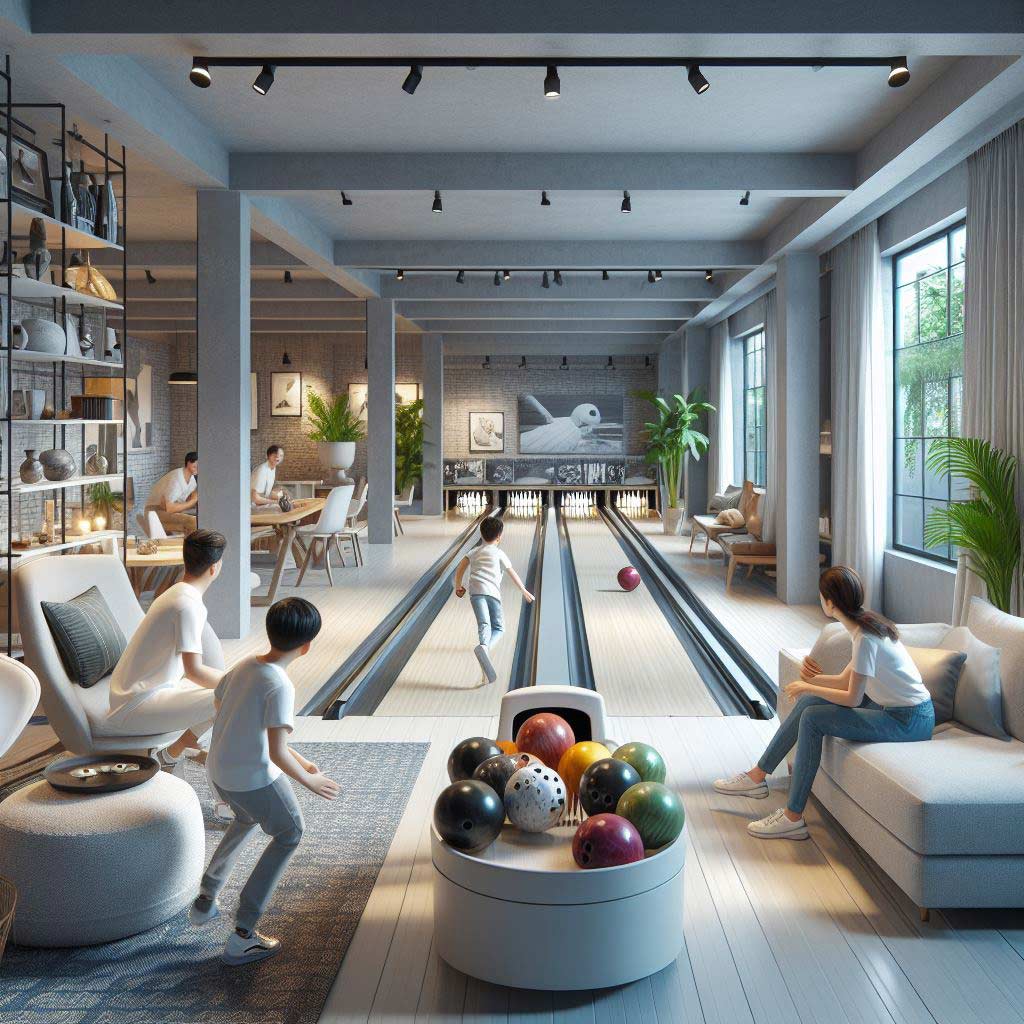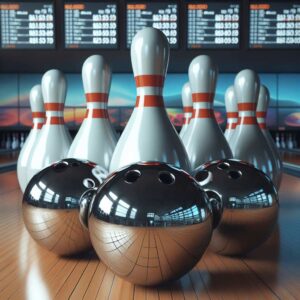Have you ever dreamed of having your own private bowling alley right in the comfort of your home? With the right amount of space and planning, you can make this dream a reality!
Installing a residential bowling alley takes your game nights, parties, and family fun to a whole new level. No more coordinating trips to the bowling center when you feel like knocking down pins. You’ll also have the coolest home around that will be the envy of all your friends and family!
Building your own alley is also more feasible than ever with advancements in synthetic lane surfaces and equipment. Plus the growth in passion for at-home recreational spaces means there are contractors who specialize in home bowling lane construction.
This guide will walk you through the entire process of planning, building, and enjoying your own home bowling alley. Follow these tips and you’ll be hosting the ultimate bowling nights in no time!
Space Requirements for a Home Bowling Alley
The first consideration for any home bowling alley project is having adequate space. This includes room for the following elements:
- The bowling lane itself. Regulation bowling lanes are 60 feet from the foul line to the headpin. But for residential lanes, anywhere from 30-40 feet is sufficient.
- Run-up space. You’ll want 15-20 feet of run-up room from the foul line for bowlers to approach the lane.
- Seating area. Make sure to allow space for seating around the lane to accommodate friends and family spectators.
- The extra room behind the lane for pin resetting equipment.
For the ideal layout, a large basement or garage conversion tends to work best. You’ll typically need an overall length of at least 45-50 feet for the complete setup. The lane can also be installed parallel to an existing wall which saves space.
Having this framing and square footage available is key for constructing a functional home bowling alley.
Choosing Quality Bowling Lane Flooring
The bowling lane itself is obviously the most critical component of your home alley. Traditional bowling lanes were made from maple wood. But in home settings, synthetic bowling lane materials are now more commonly used.
Here are some of the top-lane flooring options to consider:
- Synthetic boards – Composite laminate boards like US Bowling’s Envision lanes provide realistic bowling action and durability at a lower cost than real wood lanes.
- Fiberglass – Glossy fiberglass lanes from suppliers like Brunswick offer a contemporary style and are a high-end lane solution.
- Asphalt/Concrete – For a more basic DIY lane, pouring a flat strip of concrete or asphalt can also work. The bowling action will be sub-optimal though.
- Wood – For the most authentic experience, maple wood lanes are still available. But the costs are higher and require careful conditioning.
Synthetic bowling lanes are now very comparable to real maple in terms of ball roll, scoring, and feel underfoot. Materials like fiberglass and laminated composites also withstand heavy bowling ball impact better over time compared to wood.
When installing the lane, make sure to have a qualified contractor prepare the proper subsurface and foundations. The lanes also need precise leveling and cambering (higher center) to allow for proper ball roll.
Having quality professional installation is worth the investment to ensure your home bowling alley provides excellent ball control and an authentic bowling experience for years to come.
Selecting Your Bowling Alley Equipment
Once you have the bowling lane flooring in place, the next step is choosing pins, balls, racks, seating, and any scoring systems or other equipment.
Here are some equipment considerations for kitting out your home bowling alley:
Bowling Pins and Rack Systems
- Standard 10-pin racks – Most home lanes opt for traditional 10-pin racks and equipment. Automated machines reset the pins after each throw.
- Candlepin racks – Some New England bowlers may prefer smaller candlepin setups with thin pins that are hand-reset after throws.
- Used racks – Check bowling forums or dealers to find well-maintained used pinsetters from old bowling centers at discounted prices.
For 10-pin racks, basic tabletop units start around $5,000 while higher-end automated systems run $10,000+. Pin conveyors return balls and reset pins between throws. Installation, wiring, and maintenance add to costs as well.
Bowling Balls
Every home alley needs a rack of quality bowling balls so players can find the right fit for their fingers, grip, and weight. Having your own personal drilled balls makes the experience even better.
Scoring Systems
- Score sheets – For casual family play, paper score sheets work fine. Add up strikes and spares yourself!
- Score projectors – Classically styled projected scoring systems display scores, names, and graphics.
- Electronic scoring – Modern electronic scoring consoles provide automated scoring, stats, animations and more.
Basic projected scores start around $1,500. Higher-end electronic scoring runs $8,000-$12,000 for crisp monitors with full statistics and features.
Additional Amenities
- Seating – Arrange couches or rows of theater seating so spectators can view the lane.
- Tables – Add side tables or a bar/counter for food and drinks during play.
- Lighting – Neon signs, black lights, disco balls and other lighting adds ambiance.
Consider wireless speakers as well to play music while bowling. Every detail contributes to the authentic bowling alley atmosphere.
Obtaining Permits for a Home Bowling Alley
Before starting construction, be sure to do your due diligence on any needed permits or approvals. While zoning laws and regulations vary by region, here are some common considerations:
- Building permits – Most areas require building permits for home renovation projects of this scale to ensure proper electrical, construction, etc.
- Homeowners association rules – If part of a subdivision, get HOA approval first to avoid any issues down the line.
- Safety inspections – Professional bowling lane installation may require passing safety inspections before use.
- Property taxes – In some cases, home improvements can increase your property’s assessed value. Check on potential tax impacts.
With the right contractors and approved plans, the permitting process typically goes smoothly. Some cities even have experience with residential bowling alleys and familiar permitting procedures.
Estimating the Total Costs
So what’s the total budget for building your dream home bowling alley? While costs can vary considerably based on size, materials, and equipment, here are some ballpark estimates:
- Synthetic bowling lane (30 feet) – $7,000 to $12,000
- Wood lane (30 feet) – $10,000 to $20,000
- Automatic pinsetter – $5,000 to $15,000
- Score projector – $1,500 to $2,500
- Seating – $2,000 to $5,000
- Balls/racks – $1,000 to $3,000
- Construction/electrical – $5,000 to $15,000
Total estimate range: $25,000-$60,000+
With high-end lanes, scoring systems, and a longer run, it’s certainly possible to spend six figures for an extravagant home bowling alley. But a basic setup can also be built for under $30,000 if you save on optional amenities and decor.
Create a detailed budget and get quotes from bowling lane builders to dial in costs for your specific home layout and needs.
Design and Construction Tips
Once you’ve completed all the upfront planning and budgeting, it’s time for the fun part – starting construction! Here are some tips to ensure your home bowling alley build goes smoothly:
Optimal Lane Layout
Most home bowling lanes are installed parallel to the long side of a basement or garage space. This allows room behind the lane for seating and spectating beside the bowling action.
Leave enough side clearance so bowlers don’t hit walls on wider hooks or errant throws. And allow a buffer zone behind the pins and adequate ceiling height.
An experienced contractor can help plan an ideal lane orientation and traffic flow. Mocking it up first with tape can also help visualize spacing.
Hiring Qualified Contractors
A home bowling alley is a major construction project. Some key contractor roles include:
- Lane installation – Licensed professionals level lanes and configure pinsetters.
- Electricians – New wiring, breakers, and outlets may be required for power and scoring systems.
- Carpenters – Framing lane enclosures and building custom bars or seating.
- Finish work – Drywall, flooring, painting for the space surrounding the lane.
Bowling lane suppliers can often recommend trusted local contractors with relevant experience.
Be sure to check licenses, insurance, and references before hiring. The Bowling Proprietors Association of America also provides a nationwide professional network.
Tips for Design and Construction
Once you’ve completed all the upfront planning and budgeting, it’s time for the fun part – starting construction! Here are some tips to ensure your home bowling alley build goes smoothly:
Optimal Lane Layout
Most home bowling lanes are installed parallel to the long side of a basement or garage space. This allows room behind the lane for seating and spectating beside the bowling action.
Leave enough side clearance so bowlers don’t hit walls on wider hooks or errant throws. And allow a buffer zone behind the pins and adequate ceiling height.
An experienced contractor can help plan an ideal lane orientation and traffic flow. Mocking it up first with tape can also help visualize spacing.
Hiring Qualified Contractors
A home bowling alley is a major construction project. Some key contractor roles include:
- Lane installation – Licensed professionals level lanes and configure pinsetters.
- Electricians – New wiring, breakers, and outlets may be required for power and scoring systems.
- Carpenters – Framing lane enclosures and building custom bars or seating.
- Finish work – Drywall, flooring, painting for the space surrounding the lane.
Bowling lane suppliers can often recommend trusted local contractors with relevant experience.
Be sure to check licenses, insurance, and references before hiring. The Bowling Proprietors
Creating an Authentic Bowling Alley Ambiance
Part of the fun of a home bowling alley is making it feel like an actual alley with the right decor. Here are some ideas to recreate that bowling center atmosphere:
- Neon signs – Vintage-style neon signs with graphics like bowling pins and balls set the mood.
- Retro bowling murals – Paint a mural scene of retro bowlers or a historic alley on the wall.
- Black lights – Use black light fixtures to make lane graphics and decor pop.
- Disco ball – Hang a disco ball and get the laneside dance party started!
- Jukebox – Set the musical tone with an old-school jukebox. Curate a playlist of bowling tunes.
- Alley artifacts – Decorate with old bowling pins, balls, shoes, and trophies found online for a nostalgic decor.
- Seating – Use old metal-frame chairs or comfy retro couches for seating.
- Concession stand – Build a counter or corner concession area to serve snacks and drinks.
Let your creativity run wild to design a space that feels like stepping back in time to the golden era of bowling alleys!
Installing Quality Sound and Entertainment
Sound and video upgrades can take your home bowling experience to the next level:
- Surround sound – Install overhead and side speakers for immersive sound with bowling playlists and sound effects.
- Video screens – Mount large screens for closed-circuit view of the pins and virtual backgrounds.
- Projectors – Project cool graphics, videos or scores on the lane surface itself.
- Lighting – Program disco or colored lights to flash for strikes and celebrate high scores.
Automating sound, lighting, videos and even pyrotechnics synced to the bowling action makes your alley more thrilling! Interface systems with scoring for interactive effects.
Keeping the Lane in Top Shape
Similar to a real bowling center, the lane will need regular care and conditioning to stay slick and smooth:
- Lane oil/conditioner – Apply lane oil in the typical oil pattern to protect the lane and adjust ball roll.
- Lane cleaners – Use strong cleaners to deep clean and remove built up oil and bowling resin.
- Polishing/buffing – Buff the lane periodically to restore gloss and smoothness.
- Pin deck maintenance – Keep pin decks clean and free of debris to avoid jamming.
Do visual inspections to check for any damage or wear. Refinish or replace lanes as needed after years of play.
Following the manufacturer’s care guidelines and pro tips will maintain your home alley for decades of strikes and spares!
Enjoy Bowling at Home!
After all the hard work of planning and construction, the payoff is having your own bowling playground ready for fun anytime. Here are some ways to enjoy your new home bowling asset:
- Host league nights – Start a fun home league with friends, family, neighbors or colleagues.
- Plan bowling parties – The alley is perfect for kids birthdays, corporate events, and holidays.
- Practice your skills – Sneak in practice to improve your swing, hook and aim for bowling success.
- Relax and entertain – Casually bowl a few frames while listening to music or watching sports on TV.
- Create friendly tournaments – Hold monthy or annual tournaments to crown home bowling champions!
- Share on social media – Post photos and videos showing off your awesome home alley.
Now you can spare no expense for home excitement and entertainment with your own private bowling lanes!
Conclusion: Bringing the Bowling Alley Experience Home
Having your own bowling alley may have once seemed out of reach. But with the right dedicated space, contractors, and professional lane materials, you can now enjoy strikes, spares, turkeys and more without leaving your house.
Follow this guide to plan out your ideal layout, choose quality equipment, design an authentic atmosphere, and maintain your alley. In no time you’ll have the coolest recreation room around for family fun or competitive game nights with friends.
So grab your custom ball, shine your bowling shoes, and get ready to channel your inner Lebowski. The lanes are open in your own home sweet home!
Frequently Asked Questions
Can you make bowling alley at home?
Yes, with enough space and the right equipment, materials, and contractors, you can install a functioning bowling alley in a home basement, garage, or backyard. Synthetic lane surfaces and automatic pinsetters make home bowling alleys much more feasible.
Does a bowling alley add value to your home?
Adding a bowling alley can increase a home’s value, but typically not enough to recoup the full construction costs. It’s seen more as a luxury custom amenity that makes a home unique rather than a major value booster. Home buyers would have to place high value on the custom alley.
Is owning a bowling alley profitable?
Owning a bowling alley can be profitable, but the profit margins are often fairly low compared to the high overhead costs. Location, modern amenities, leagues/events, and excellent service are key factors in successful bowling alleys. Residential alleys are mainly for personal recreation rather than profit.
How much space do you need to build a bowling alley?
For a regulation bowling lane, you need at least 60 feet in length. But a 2-4 lane home alley can be built with as little as 40 feet for a shortened lane. Allow 15+ feet of run-up space and seating area as well. Overall 1,500-2,000 sq ft or more is ideal.
How do you make a homemade bowling set?
Use plastic bottles or cardboard tubes as DIY bowling pins and a softball as the bowling ball. Set up plywood tracks or clear plastic lanes from home improvement stores. Use toy construction sets like bowling lane bumpers. Score with pen and paper.
How do you build a bowling lane in your backyard?
Install a smooth, flat, and level patio or concrete slab outdoors. Apply polyurethane finish to protect the surface. Set up portable pins and score. Build a shelter over it with a roof to allow play when raining. Install lighting for night bowling.
Why are bowling alleys in basements?
Bowling alleys are often in basements because the underground space allows for the long and wide lane dimensions. The space is also easier to insulate from sound. Being below ground level provides consistency in temperature which is important for proper bowling ball motion.
Can you bring your own bowling ball to a bowling alley?
Yes, most bowling alleys will allow you to bring your own custom ball to use instead of house balls. Many serious bowlers own their ball for the proper fit. The alley may inspect the ball to ensure it meets size and weight standards. They may also charge a small fee to use your own ball.
Does bowling require expensive equipment?
Basic bowling with house balls at the local alley can be done cheaply. But those looking to bowl frequently or competitively will want to invest in their own fitted ball, shoes, gloves, ball maintenance tools, and other gear. Serious players may spend $1,000+ on high-end equipment.





